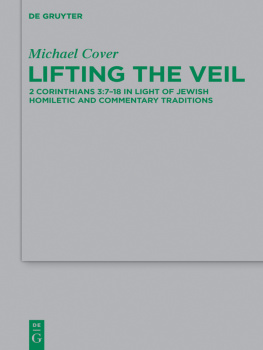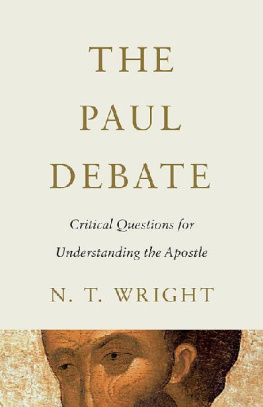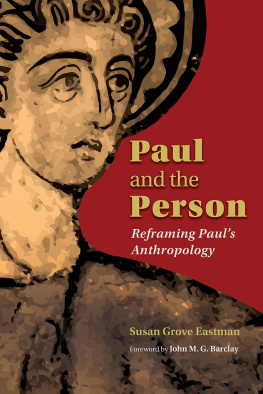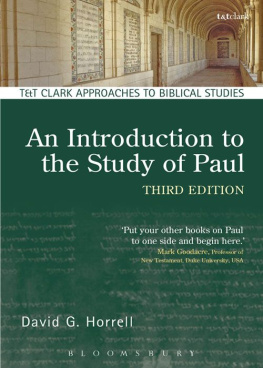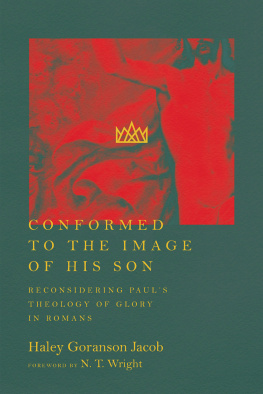Paul and the
Image of God
Paul and the
Image of God
Chris Kugler
Foreword by N. T. Wright
LEXINGTON BOOKS/FORTRESS ACADEMIC
Lanham Boulder New York London
Published by Lexington Books/Fortress Academic
Lexington Books is an imprint of The Rowman & Littlefield Publishing Group, Inc.
4501 Forbes Boulevard, Suite 200, Lanham, Maryland 20706
www.rowman.com
6 Tinworth Street, London SE11 5AL, United Kingdom
Copyright 2020 by The Rowman & Littlefield Publishing Group, Inc.
All rights reserved . No part of this book may be reproduced in any form or by any electronic or mechanical means, including information storage and retrieval systems, without written permission from the publisher, except by a reviewer who may quote passages in a review.
British Library Cataloguing in Publication Information Available
Library of Congress Control Number: 2019952837
ISBN 978-1-9787-0738-2 (cloth : alk. paper)
ISBN 978-1-9787-0739-9 (electronic)
 The paper used in this publication meets the minimum requirements of American National Standard for Information SciencesPermanence of Paper for Printed Library Materials, ANSI/NISO Z39.48-1992.
The paper used in this publication meets the minimum requirements of American National Standard for Information SciencesPermanence of Paper for Printed Library Materials, ANSI/NISO Z39.48-1992.
Contents
N. T. Wright
What did Paul believe about Jesus? That question has haunted the study of early Christianity for many generations, especially because Pauls letters are universally recognized as our earliest sources for Christian belief. Theories have come and gone, with some seeing Pauls Jesus as merely human, leaving any divine implications to a later stage of development, and others insisting that for Paul Jesus embodied the preexistent second person of the Trinity. This question has been bound up with a broader one: How Jewish, or how Hellenized, was Pauls thought in general and his Christology in particular? Until the last generation it was assumed that these questions interlocked, so that the more Jewish Pauls thought was the lower his Christology, and the more Hellenized he was the higher the Christology. More recent study, following Martin Hengels game-changing Judaism and Hellenism (1974), has seen this as a false either/or. The Christological debate has once again become wide open, with strong arguments now being made in favor of an early, high, Jewish Christology, associated variously with the work of Larry Hurtado, Richard Bauckham, and others.
The question remains complex, however. This is partly because the texts where Paul brings his view of Jesus to rich expression are notoriously dense, packed with quasi-technical terms whose meaning is itself disputed. Whats more, these texts regularly form part of larger arguments whose intended drift has likewise been a matter of controversy. Then there is the question of the cultural echo-chamber within which Paul expected his writing to be heard, and at that point we find new versions of the old Judaism/Hellenism divide: Was Paul thinking and writing like a Hellenistic philosopher, or like an apocalyptic Jew? Or is there a tertium quid , a middle way in which perhaps he was straddling both? How would we know, and how might that tip the balance of argument one way or the other? At this point the faint-hearted might be tempted to give up the struggle and conclude that we cannot and will not ever know.
The present volume shows that one young scholar at least is not faint-hearted. Dr. Chris Kugler has mastered Pauls writings, particularly the dense and difficult passages about Jesus, and has made himself thoroughly familiar as well with the Jewish and Hellenistic texts and traditions which shimmer, often tantalizingly, in the background. Indeed, he argues here that while Pauls debt to the Jewish wisdom tradition is clear, with Jesus in some ways taking the role that wisdom, Sophia , had played in some Jewish texts, this tradition by itself is not enough to explain the subtle way he then expresses the role of Jesus (or, we should say, the mysterious one who became the human being Jesus). At this point, Dr. Kugler proposes that Paul drew on the larger world we loosely call Middle Platonism, which we know in such writers as Philo and Plutarch, to find a way of expressing what he believed had to be said about Jesus: particularly, that Jesus was to be seen as the active agent in the creation of the world itself. For a Jew, that meant that Jesus was doing what only God himself does. Paul was thus addressing debates which had arisen from within the Jewish world; but he was borrowing, for this purpose, the linguistic and philosophical terms of the larger Greek environment.
This, Kugler proposes, had an extra advantage for Paul, over and above the achievement of fresh clarity in articulating Jesuss role.




